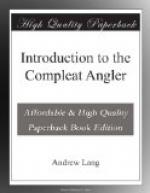No more is known of Walton till the happy year 1660, when the king came to his own again, and Walton’s Episcopal friends to their palaces. Izaak produced an ‘Eglog,’ on May 29:—
’The king! The king’s
returned! And now
Let’s banish all sad thoughts,
and sing:
We have our laws, and have our king.’
If Izaak was so eccentric as to go to bed sober on that glorious twenty-ninth of May, I greatly misjudge him. But he grew elderly. In 1661 he chronicles the deaths of ’honest Nat. and R. Roe,—they are gone, and with them most of my pleasant hours, even as a shadow that passeth away, and returns not.’ On April 17, 1662, Walton lost his second wife: she died at Worcester, probably on a visit to Bishop Morley. In the same year, the bishop was translated to Winchester, where the palace became Izaak’s home. The Itchen (where, no doubt, he angled with worm) must have been his constant haunt. He was busy with his Life of Richard Hooker (1665). The peroration, as it were, was altered and expanded in 1670, and this is but one example of Walton’s care of his periods. One beautiful passage he is known to have rewritten several times, till his ear was satisfied with its cadences. In 1670 he published his Life of George Herbert. ’I wish, if God shall be so pleased, that I may be so happy as to die like him.’ In 1673, in a Dedication of the third edition of Reliquiae Wottonianae, Walton alludes to his friendship with a much younger and gayer man than himself, Charles Cotton (born 1630), the friend of Colonel Richard Lovelace, and of Sir John Suckling: the translator of Scarron’s travesty of Virgil, and of Montaigne’s Essays. Cotton was a roisterer, a man at one time deep in debt, but he was a Royalist, a scholar, and an angler. The friendship between him and Walton is creditable to the freshness of the old man and to the kindness of the younger, who, to be sure, laughed at Izaak’s heavily dubbed London flies. ‘In him,’ says Cotton, ’I have the happiness to know the worthiest man, and to enjoy the best and the truest friend any man ever had.’ We are reminded of Johnson with Langton and Topham Beauclerk. Meanwhile Izaak the younger had grown up, was educated under Dr. Fell at Christ Church, and made the Grand Tour in 1675, visiting Rome and Venice. In March 1676 he proceeded M.A. and took Holy Orders. In this year Cotton wrote his treatise on fly-fishing, to be published with Walton’s new edition; and the famous fishing house on the Dove, with the blended initials of the two friends, was built. In 1678, Walton wrote his Life of Sanderson. . . . ’’Tis now too late to wish that my life may be like his, for I am in the eighty-fifth year of my age, but I humbly beseech Almighty God that my death may be; and do as earnestly beg of every reader to say Amen!’ He wrote, in 1678, a preface to Thealma and Clearchus (1683). The poem is attributed to John Chalkhill, a Fellow of Winchester College, who died, a man of eighty, in 1679. Two of his songs are in The Compleat Angler. Probably the attribution is right: Chalkhill’s tomb commemorates a man after Walton’s own heart, but some have assigned the volume to Walton himself. Chalkhill is described, on the title-page, as ‘an acquaintant and friend of Edmund Spencer,’ which is impossible. {4}




